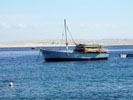
The growing trove of U.S. diplomatic cables released by Wikileaks has most recently made clear some of the Obama administration’s frustrated attempts to halt arms flows between unsavory regimes and actors—notably from the likes of Iran, Syria, and North Korea into the hands of Hamas and Hezbollah. A recurring character in these global transactions, according to the U.S. cables, is Sudan.
While these allegations are not new, the cables are a reminder of previously documented links between Sudan and Iran—the second largest small arms supplier to Khartoum according to a report (pdf) last year by Small Arms Survey—and of Khartoum’s role in Middle East politics. Sudan’s (however undefined) role in supplying Hamas is also an uncomfortable thought given a recent U.S. offer to consider removing Khartoum from the state sponsor of terror list as an incentive for ongoing negotiations.
U.S. cables also document the sale of tanks to South Sudan by Ukraine and confirm Egyptian fears over losing access to the Nile should secession take place.
Here’s a quick summary of reports from The Guardian, AFP, and The New York Times that chronicle in detail U.S. diplomats’ belief in early 2009 that Sudan served as a transit point for arms flows from Iran to Hamas.
– A January 2009 cable directed U.S. officials to tell Khartoum to stop flights from Sudan believed to be carrying weapons from Iran destined for Hamas. Diplomats were told to express “exceptional concern” to the Khartoum government.
– A February 2009 cable described a confrontation with Sudanese Ambassador Nasreddin Wali, who believed that the U.S. was behind two bombings in eastern Sudan that took place in January and February. “We assume that the planes that attacked us are your planes,” the Sudanese official said. “We protest this act and we condemn it.” (In March 2009, Time magazine reported that Israeli pilots bombed an Iranian weapons convoy in eastern Sudan in mid-January. According to the report, the arms shipment was bound for the Gaza Strip. Whether this was the same attack referenced in the cable is unclear.)
– In a March 2009 cable indicated that U.S. officials said they believed Iran had intentions of shipping weapons to Syria that would pass through Sudan to reach Hamas. Diplomats were instructed to ask officials in Jordan and Egypt to stop the expected flights.
– References to the arms flow were made in April and June in cables describing interactions with Egyptian and Israeli officials. (In a June 2009 cable Israeli Prime Minister Benjamin Netanyahu reportedly told U.S. officials there was “a steady flow of Iranian weapons to Gaza through Sudan or Syria and then by sea.”)
– A July 2009 cable from the U.S. embassy in Yemen said that “a significant volume of arms shipments to Hamas” transit from Yemen to Sudan in small wooden ships that are difficult to discern from other vessels. Once in Sudan, the weapons are then transported by car to Gaza.
The uncovered cables do not indicate whether the U.S. believes arms flows continued after July 2009. Sudanese officials appear to have at times agreed to cooperate while also denying the alleged connections. According to the previously mentioned January 2009 cable, then Sudanese Foreign Minister Deng Alor indicated he “strongly supported” stopping the flights that the U.S. alleged were being used to ship arms, while The Guardian reports that the Sudan foreign ministry at the time said the government’s position would be that Khartoum was not allowing the import of weapons from Iran. According to The New York Times, Khartoum previously insisted to the U.S. that suspected shipments only contained farm equipment. A Sudanese spokesperson has also denied these most recent allegations.
Photo: According to AFP, arms shipments destined for Hamas have been transported in small wooden ships from Yemen to Sudan across the Red Sea. (Small Craft Advisor blog)

